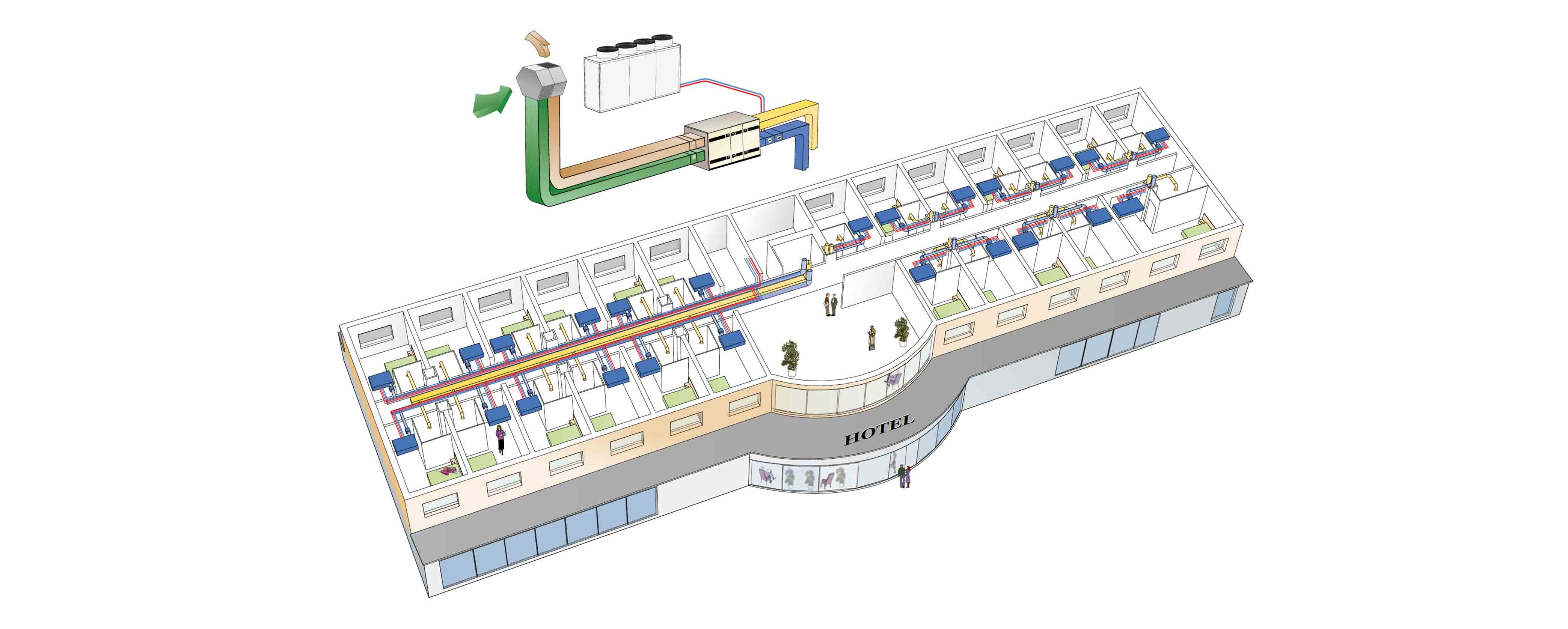Hotels
The no. 1 financial ratio in the hotel sector is the occupancy rate, i.e. the number of rooms occupied relative to the total number of rooms available. This financial ratio is directly dependent on hotel guest well-being, since satisfied guests are more likely to return.

Guest satisfaction is crucial
The main requirements made by hotel guests is for their hotel room to be fresh, quiet and comfortable. All of us will at some time have had to put up with a hotel room with centrally controlled ventilation that could not be adjusted, and which rumbled or wheezed, and where the temperature was either too high or too low. This is why most guests appreciate being able to adjust both the ventilation and temperature of their room. The requirement for a system solution is then to create an individually demand-controlled indoor climate while maintaining high-level energy efficiency and cost-efficient operation.
Long ventilation ducts do the job
Hotel rooms are usually located one after another, which for ventilation purposes typically involves extensive branched ducting. The effect of this may be large differences in pressure drop between the first and last supply air diffuser serving main ducts, with the resulting noise problem and non-adjustability factor. The lesser the pressure that needs to be throttled in the supply air diffuser, the quieter the system.
Holistic approach is crucial
The design principles for a demand-controlled ventilation system for a hotel should address all factors coherently and comprise all the necessary components. An example of such a system would be a typical five-storey hotel. The system solution involves division into two sub-systems which jointly provide a whole raft of economies as compared with conventional hotel solutions.
Sleeping risks in smoke and fire scenario
In a fire emergency, it is vital that automatic smoke and fire dampers installed in a building respond immediately to either contain smoke and fire, preventing the spread across the building, or open to allow smoke extraction to take place, using dedicated panel to regularly test dampers and a good cause and effect will keep guests safe.
Regular Smoke and Fire Damper Testing
In hotels, downtime and disruption can be costly, complex and frustrating for staff and occupants. Installing dedicated controls and monitoring will maximise building safety and ensure good containment of smoke and fire, preventing the spread across the building.
Correctly located supply air diffusers for health and well-being
The design of the supply air diffusers, the type of diffusers and their siting are all key factors to take into account. The choice of diffuser type and siting must factor in the layout of hotel room furnishing, i.e. where the bed, TV and desk are placed. With this in mind, you will be able to identify the right solutions so that hotel guests do not perceive the room as draughty due to misplaced supply air diffusers. Bear in mind that any subsequent rearrangement of the furnishings may require redirection or replacement of the supply air diffusers.
A multifunctional unit controls cooling and heat production
The individual hotel rooms are air-conditioned and ventilated using compact comfort modules, and the control systems are connected to a centrally located air handling unit. Public areas in the hotel such as the restaurant, lobby and conferencing suite are air conditioned by means of maintenance-free comfort modules. Connecting flow controls to the air handling unit optimises fan operation to stabilise the room climate in all the rooms. For enhanced air distribution, branch dampers can be installed.
High savings potential
With the latest presence sensors, hotel rooms equipped with demand-controlled ventilation, including heating/cooling, improve their energy performance overall by 30%. When the hotel guest is not present in their room, the ventilation rate will be lowered, for example, which is obviously a great advantage. A full 80% of electrical energy for powering the fans and 40% of the heating and cooling energy can be saved as compared with constant air flow and temperature, without detriment to hotel guest comfort.